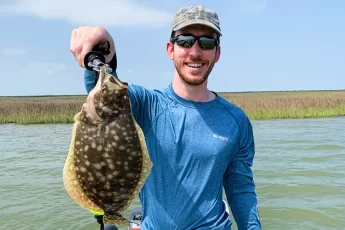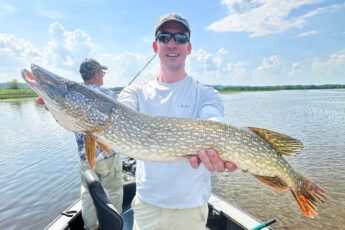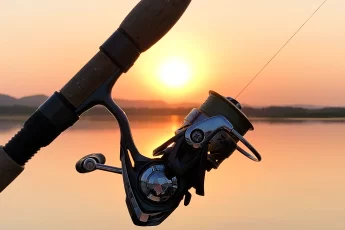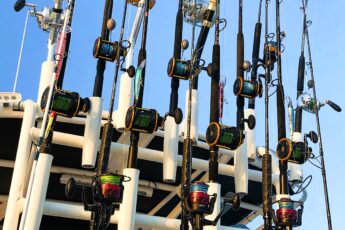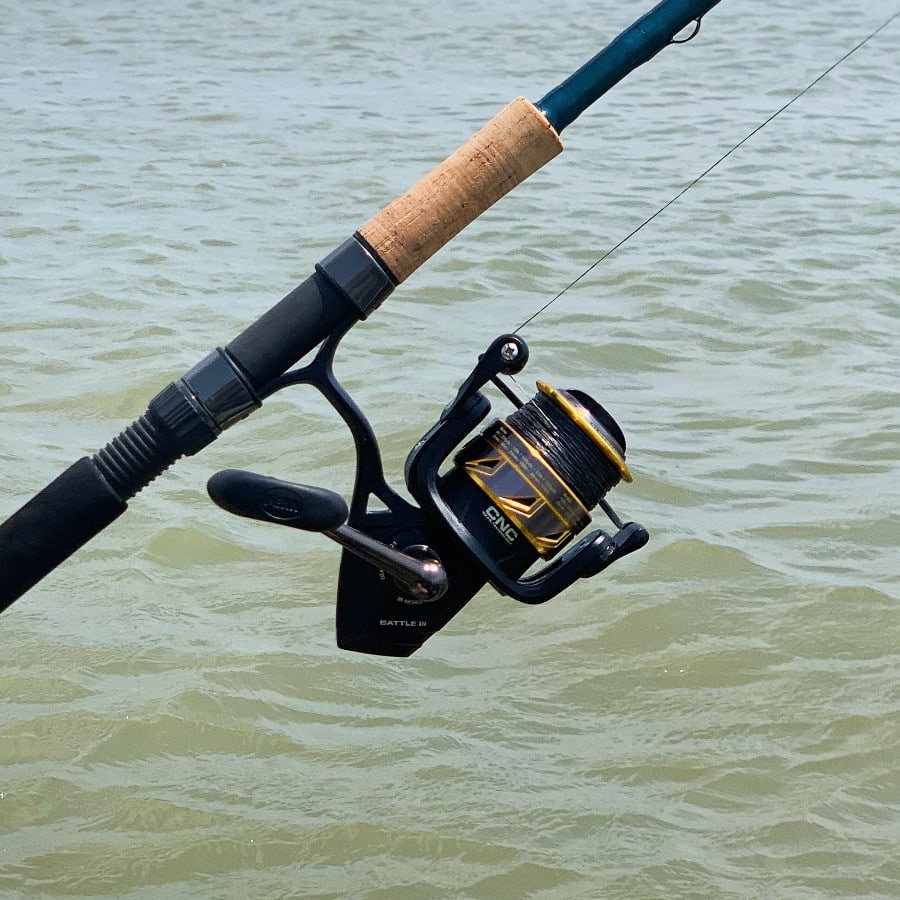
Updated 12/29/2023
Surf fishing is a popular and exciting way to spend a day at the beach, jetty, or pier, but requires the right equipment to be successful. One of the most important pieces of equipment for surf fishing is the reel.
The best surf fishing reels should be durable, reliable, and capable of handling the demands of surf fishing. In this article, we take a look at the top surf fishing reels on the market, considering factors like price, performance, quality, and value.
Whether you are a beginner or an expert angler, these reels are sure to meet your needs and help land your next big catch!
*Disclosure: I only recommend products I would use myself and all opinions expressed here are my own. This post may contain affiliate links that at no additional cost to you, I may earn a small commission.
Our Top 7 Picks
- Best Overall Spinning Reel: Penn Battle III Spinning Reel
- Best Spinning Reel Under $100: KastKing Sharky III Spinning Reel
- Best Spinning Reel Under $150: Daiwa BG Spinning Reel
- Best Fully Sealed Spinning Reel: Penn Spinfisher VI Spinning Reel
- Best Baitcasting Reel for Wade Fishing: Shimano Curado M
- Best Conventional Reel: Penn Fathom II Conventional Reel
- Best Splurge: Shimano Stella SW Spinning Reel
The 7 Best Surf Fishing Reels
Whether you’re a new angler or a grizzled expert, we have you covered. Check out our recommendations for best overall, budget surf rod options, and the best splurge amongst others!
1. Penn Battle III Spinning Reel
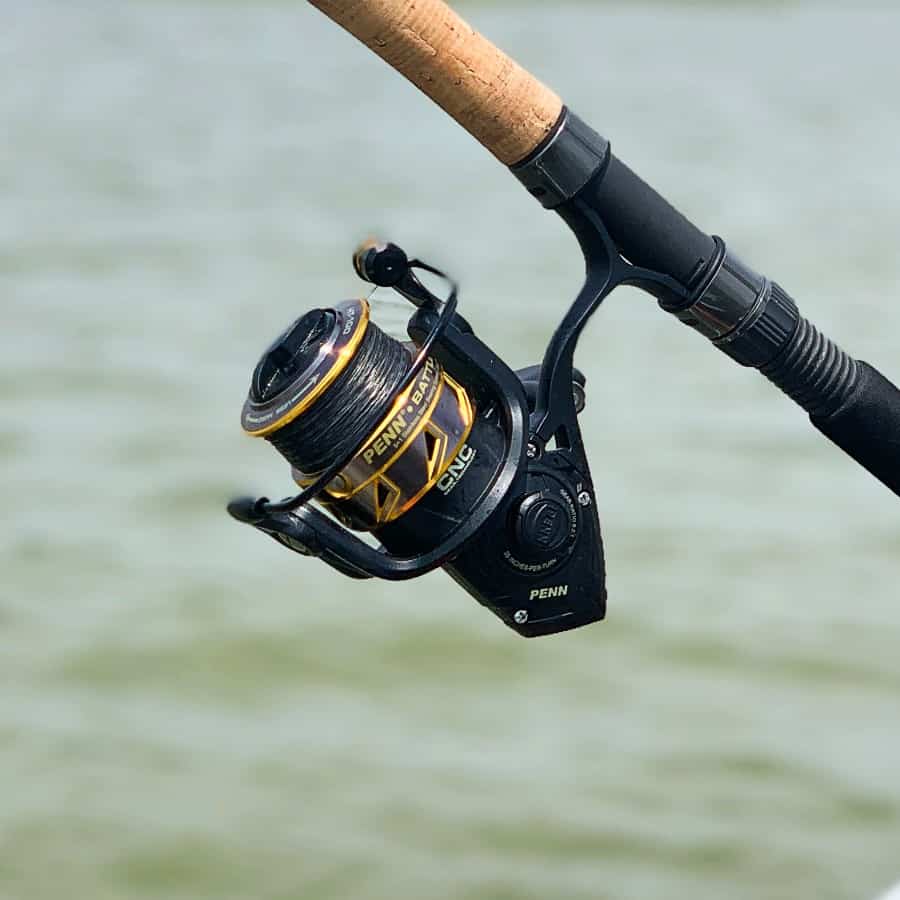
- Reel Sizes: 1000 to 8000
- Gear Ratio: 4.2:1 to 7.0:1
- Max Drag: 9 to 40 lbs
- Ball Bearings: 5+1
- Weight: 7.8 to 38.8 oz
Pros:
- Premium reel features for reasonable price
Our top choice overall is the Penn Battle III spinning reel which we feel is that perfect mix of premium quality with a manageable price tag. This reel was the 2020 ICAST Online Best of Category Winner – Saltwater Reel for good reason!
The Battle III includes a 5+1 sealed stainless steel ball bearing system, Penn’s HT-100 carbon fiber drag washers, and a full metal aluminum body and side plate. It is high quality designed for durability and performance and Penn really outdid themselves with the attention to detail. Line capacity rings on the spool make for an easy visual reference to tell how much line you have to spare.
The material choices make for a lightweight reel with great corrosion resistance. Also, the spool is considered a ‘Superline Spool’ or a braid-ready spool. This means there is a little rubber ring on the spool that lets you directly tie braid to the spool without it slipping. A nice touch!
2. KastKing Sharky III Spinning Reel

- Reel Sizes: 1000 to 5000
- Gear Ratio: 5.2:1
- Max Drag: 33 to 39.5 lbs
- Ball Bearings: 10+1
- Weight: 7.4 to 10.6 oz
Pros:
- Budget friendly but still fit for purpose
Our choice for the best surf spinning reel under $100 is the KastKing Sharky III spinning reel. You don’t need to break the bank for quality equipment. This reel hits above its weight class and gets the job done.
The key factor when picking a budget surf spinning reel is to ensure manufacturers build it for saltwater. Saltwater construction means corrosion resistance materials and quality seals for rotating components. The reel is surprisingly smooth for its price point with a 10+1 bearing system.
The Sharky III has some great features like the K.I.S.S. (KastKing Intrusion Shield System) sealing system to improve water resistance for the spool, body, and rotor. The aluminum spool has a rubber backing to allow direct spooling of braided fishing line.
This reel contains most of the features of a high end reel but is priced for value.
While this reel may corrode faster than some of the higher end options on the list, if you take care of your reel with freshwater rinses and routine maintenance it should last quite a long time.
3. Daiwa BG Spinning Reel

- Reel Sizes: 1500 to 8000
- Gear Ratio: 5.3:1 to 5.7:1
- Max Drag: 4.4 to 33 lbs
- Ball Bearings: 6+1
- Weight: 8.5 to 30 oz
Pros:
- Great all around reel
Our pick for the best surf spinning reel under $150 is the Daiwa BG Spinning Reel. It’s a solidly constructed, quality reel that is perfect for targeting big fish in the surf.
We love the Daiwa BG spinning reel in size 4000 as a great all-around surf fishing reel that should last forever.
The reel includes Daiwa’s Automatic Tournament Drag (ATD) that reduces initial drag start-up inertia to create a smoother drag from initial startup. It also has digitally engineered gears to optimize speed, power, durability, and smoothness. Daiwa claims their tests reveal their reel gear life up to three times longer than competitors reels! We’re always looking for equipment that will last forever and this reel can take a beating.
Also, it doesn’t hurt that this reel just plain looks great with its sleek black anodized machined aluminum housing!
4. Penn Spinfisher VI Spinning Reel
- Reel Sizes: 2500 to 10500
- Gear Ratio: 4.2:1 to 6.2:1
- Max Drag: 15 to 50 lbs
- Ball Bearings: 5+1
- Weight: 10.7 to 38.6 oz
Pros:
- Heavy duty workhorse
- Live line option
Penn’s Spinfisher VI is a workhorse surf and offshore fishing reel. Featuring an IPX5 sealed body and spool, full metal body/side plates, and a 5+1 sealed stainless steel bearing system, the Spinfisher VI has great durability and strength at a fair price point. The larger models have incredible max drag capabilities of up to 50 pounds which is more than enough for the largest surf species.
Just like with the Penn Battle III, the Spinfisher VI’s spool has the nice touches of a rubber backing superline spool that is ready for braid plus the line capacity rings for quick visual reference for how much line is left on the spool.
We like that the Spinfisher VI comes in a wide variety of sizes plus styles. Specifically, the live-line version is great for surf fishing. The live-line version has an additional switch on the reel that, once toggled, allows the spool to free-spool without flipping the bail. A great additional feature for surf anglers that fish with cut bait and circle hooks!
5. Shimano Curado M Baitcasting Reel

- Gear Ratio: 6.2:1 – 8.5:1
- Max Drag: 12 – 13 lbs
- Ball Bearings: 6+1
- Weight: 7.4 – 7.6 oz
Pros:
- Butter smooth
- Great casting distance
- Marketed for freshwater and saltwater
Our choice for best baitcasting reel for wading is the Shimano Curado M. We picked it as our top choice because it’s a no-frills, high value proposition reel that’s built to last. We prefer baitcasting reels for wading with artificial baits because of the comfort for repeated casting.
This reel is smooth as butter and feels like you can cast it a mile. It’s built for reliability and durability, rated for both freshwater and saltwater, and is an absolute delight to fish with.
Shimano recently released the Curado M as their flagship replacement for the Curado K. Compared to the Curado 200K, the Curado 200M is 0.2 oz lighter, has 2 lb higher max drag rating, and has Shimano’s MagnumLite (MGL) Spool III that reduces start-up inertia for unparalleled casting performance. Also, they added the SilentTune technology that reduces spool noise during casts.
The Curado M features Shimano’s latest MicroModule gearing they claim as super smooth and efficient. Spoilers, it is.
The Curado M can do anything you want a baitcaster for saltwater species to do from chucking soft plastics to throwing spoons.
I could go on and on about this reel. Suffice to say, if you want a smooth, durable, multi-function, long lasting baitcasting reel, the Shimano Curado M is a great choice.
If we had to pick one downside of this reel for saltwater fishing is the limited drag compared to other options on this list. If targeting huge fish, we recommend checking out the competition.
Check out our article on the best saltwater baitcasting reels for other great options.
6. Penn Fathom II Conventional Reel
- Reel Sizes: 12 to 40
- Gear Ratio: 4.8:1 to 6.1:1
- Max Drag: 30 lbs
- Ball Bearings: 6
- Weight: 16.2 to 20.7 oz
- Brakes: Centrifugal or Magnetic
Pros:
- Accurate, long distance casting
For the surf angler that needs long, precision casting, it may be worth going with a conventional reel. Conventional reels are not as beginner friendly, but in the right hands will cast with better accuracy and casting distance than spinning reels.
Our choice for the best conventional surf reel is the Penn Fathom II. We’re always looking for high quality equipment at a value price point, and the Fathom II delivers. The Fathom II has a full metal body/sideplates, a 6 shielded stainless steel ball bearing system, anti-reverse bearing, and star drag.
Check out our article on best conventional reels for other great options.
7. Shimano Stella SW Saltwater Spinning Reel
- Reel Sizes: 4000 to 20000
- Gear Ratio: 4.4:1 to 6.2:1
- Max Drag: 24 to 62 lbs
- Ball Bearings: 13+1
- Weight: 14.8 to 34.2 oz
Pros:
- The best money can buy
The Shimano Stella SW Saltwater Spinning Reel is a powerhouse reel featuring the best materials and build quality available on the market. The reel is built with a Hagane body which is a solid metal reel body with high rigidity and impact resistance.
This reel is butter smooth from the 13+1 bearing system. It also includes Shimano’s X-Protect sealing design that all-but makes this reel impenetrable to water intrusion.
The Shimano Stella SW is available in a huge range of sizes perfect for surf fishing for even the biggest of offshore fish species. It isn’t the lightest reel around, but it’s built to perform and built to last.
Reel Comparison Table
Check out our handy comparison table showing key specifications for our top reel choices.
| Reel Name | Reel Sizes | Gear Ratio | Max Drag | Ball Bearings | Weight |
|---|---|---|---|---|---|
| Penn Battle III Spinning Reel | 1000 to 8000 | 4.2:1 to 7.0:1 | 9 to 40 lbs | 5+1 | 7.8 to 38.8 oz |
| KastKing Sharky III Spinning Reel | 1000 to 5000 | 5.2:1 | 33 to 39.5 lbs | 10+1 | 7.4 to 10.6 oz |
| Daiwa BG Spinning Reel | 1500 to 8000 | 5.3:1 to 5.7:1 | 4.4 to 33 lbs | 6+1 | 8.5 to 30 oz |
| Penn Spinfisher VI Spinning Reel | 2500 to 10500 | 4.2:1 to 6.2:1 | 15 to 50 lbs | 5+1 | 10.7 to 38.6 oz |
| Shimano Stella SW Saltwater Spinning Reel | 4000 to 20000 | 4.4:1 to 6.2:1 | 24 to 62 lbs | 13+1 | 14.8 to 34.2 oz |
Conclusion
In conclusion, having the right surf fishing reel is essential for a successful day fishing. There are many great options available, but the Penn Battle III Spinning Reel stand out as our best overall choice. This reel offers a balance of performance, durability, and value that makes it a great choice for any surf angler.
Having the right surf fishing reel is only the start. Make sure you know everything about surf fishing to increase your odds of a successful trip!
Check out our articles for great rods to pair with these reels:
- Best Surf Fishing Rods
- Best Saltwater Fishing Rods
- Best Inshore Fishing Rods
- Best Sheepshead Rods
- Best Pier Fishing Rods
- Best Trolling Rods
Check out our related reel articles:
How to Choose The Best Surf Fishing Reel For You
Key factors for choosing the best surf fishing reel include reel size, line capacity, build/material quality. Surf reels are generally bigger than other reels because of the long casting distances and larger target fish species. Casting to the first sandbar vs the second sandbar can be the difference between catching nothing or a cooler-full of surf fish!
Baitcasting Reel vs Spinning Reel vs Conventional Reel
Surf fishing may be best performed with baitcasting reels, spinning reels, or conventional reels, depending on the target fish species and fishing technique.
Most techniques for targeting smaller saltwater fish can be done with either spinning or casting setups. Spinning reels are better for beginners because they can’t backlash like baitcasting setups. Spinning reels are generally preferred for bottom rig fishing live bait or super light setups. Baitcasting setups allow for more accurate casting and improved casting comfort but can be more difficult to use.
If getting one reel to do everything, we recommend a spinning setup to start. If grabbing an additional rod and reel for wading to cast lures, soft plastics, or about anything that requires frequent casts, we recommend baitcasting reels.
For surf fishing for the biggest fish, conventional reels are a great option because they have the largest spool capacities, highest drag ratings, and features to catch huge fish.
Line Capacity
Line capacity refers to how much fishing line fits on the reel. The total spool capacity is specified by mono vs braid and line strength as pound test. An example line capacity would be “200 yards of 20-pound test braid”.
Braid is smaller diameter than mono at the same line strength which means you can fit more braid on a reel. Also, higher pound test line is larger diameter and will take up more space on the reel spool.
Since surf fishing requires long casting distances and large diameter line, line capacity is an important consideration. When I pick a surf reel, I make sure it can fit 200+ yards of braid at the strength I want. I usually put 20-40 lb braid on my surf reels. Some people will size up to 80+ pound test if targeting huge species like sharks.
Ball Bearings
Ball bearings in fishing reels are small, spherical bearings that reduce friction and increase smoothness of a reel’s operation. They are located within the internal mechanism of the reel and allow the reel’s moving parts to rotate smoothly against each other.
Most quality reels have at least four ball bearings. More ball bearings is usually better because the higher the number of ball bearings, the more friction is reduced and less wear and tear on the internal reel components. That said, ball bearing quality and material choice is also important. I would rather have four high-quality ball bearings than ten low quality bearings.
Most ball bearings are stainless steel but can also be ceramic. Many reels list something like “5+1 bearings” – this reel would be five ball bearings plus one roller bearing.
Drag System
Drag systems on fishing reels provide resistance to the spool as line is retrieved. A loose drag makes it easier for the spool to spin freely and a tight drag makes it difficult to rotate the spool.
Drag systems work using a series of washers or disks pressed together by a drag knob or level (usually on the top of spinning reels). As the drag is tightened, the drag washers are pressed together which increases resistance on the spool. Drag should be set to match the strength and size of the target fish species.
Setting the drag properly is an art. You want the drag tight enough to reel in the fish, but not tight enough where a strong pull could snap your line or cause your fishing knot to fail. When the drag is properly set, a strong pull from a fish should be able to pull some line from your reel.
Pro tip for setting drag when surf fishing – if you place your rod in a rod holder, drastically loosen the drag. If the drag is tight, a big fish could pull your whole rig into the water! Not a good day!
The two popular types of drag are lever drag and star drag.
Lever Drag
Lever drag reels use a lever on the side of the reel to the drag. These reels have preset drag positions that usually include free spool, bait, strike, and max settings but also allow for micro adjustments to really dial-in the drag. Lever drags are best used when targeting the largest fish, 30 lbs or larger, because drag settings can quickly be set for each phase of the catch. The common wisdom is the strike drag setting should be one third of the strength of the line. For example, 60-lb line should have a 20 lb strike setting.
Star Drag
Star drag reels can be identified by the star-shaped drag adjustment wheel just inside of the handle. They allow for on-they-fly adjustment and are a good option when it’s possible to hook into a variety of fish sizes that require different drag settings. Star drag reels are considered to cast slightly better than lever drags, but that’s usually not a big issue on high-quality reels. If targeting smaller fish, under 30 lbs, with a conventional reel, we recommend leaning towards a star drag. One downside of star drag reels is you can’t tell what the drag setting is just by glancing at the reel like you can with lever drag.
Gear Ratio
The gear ratio on a fishing reel refers to the relationship between the number of turns on the spool for every turn of the handle. For example, a gear ratio of 5:1 means the spool rotates five times for every turn of the handle.
Gear ratio is an important consideration when selecting a fishing reel because it affects the speed at which you can retrieve your line. A higher gear ratio is better for situations where you need to reel long distances or require fast bait presentations. A lower gear ratio is preferred for situations where a lower retrieval rate is desired, like when using finesse techniques.
Most reels have a gear ratio between 4:1 to 7:1. Many medium size reels are around 6.2:1 gear ratio which is a great for most applications. Higher gear ratios are preferred for surf fishing due to the long reeling distances.
Level Wind
A level wind on a conventional or baitcasting is a mechanism that evenly distributes line on the spool as the angler reels in. Most low-profile baitcasting reels having a built-in level wind system. Conventional reels can come with or without.
Level wind reels have pros and cons. The advantages of having a level wind reel is they are easier for beginners because the angler doesn’t have to manually distribute the line on the reel. The cons are, level wind systems can bind when reeling in massive fish and tend to have shorter casting distances than their non-level wind counterparts because of the friction caused through the level-wind mechanism. Also, when casting long rods like 10-15′ surf rods, the best practice is to “bundle” line evenly on the reel because it will come off the spool smoother when high-speed casts quickly rip line off the reel. Birds nests also tend to be worse on level wind reels than on non-level wind reels.
We generally prefer conventional surf reels without a level wind because it allows for maximum casting distances but this definitely shouldn’t be a deal breaker if you find a reel you really like.
Material Quality
Material quality is an important consideration for picking a surf reel. Surf fishing reels are typically made of a combination of metal, rubber, and plastic parts. The body of the reel is usually made of aluminum or another type of metal to provide strength and durability. Plastic is used for many of the peripheral parts like the handle or drag knob because it is lightweight and corrosion-resistant.
Rubber seals may be used to protect against water, dirt, and sand ingress. High-end reels may have ceramic bearings or higher quality metal components.
Look for reels made of high-quality materials with solid, durable construction.
Reel Brakes
Baitcasting reels have reel brakes. When you make a cast with a baitcasting reel, the momentum of the bait pulls line off of the spool. The spool rotates fastest at the beginning of the cast when forces are the highest. The reel brake slows down rotation of the spool to keep the fishing line tight on the spool and stop a backlash mess.
Brakes are important because if the spool rotates faster than the speed your bait is pulling out line, your reel will become a huge backlash mess.
There are three main types of brakes on fishing reels: centrifugal brakes, magnetic brakes, and digitally controlled brakes.
Centrifugal Brakes
Centrifugal brakes work by using a series of small weights that are pushed outward by centrifugal forces when the spool beings to spin. This increase resistances on the spool. To adjust centrifugal brakes, the side plate must be removed.
Magnetic Brakes
Magnetic brakes work by using a series of magnets to create resistance on the spool. They are considered more precise and higher quality than centrifugal brakes. Magnetic brakes are adjusted by a small dial on the side of the reel and can be fine tuned to adjust the resistance that is applied to the spool.
Digitally Controlled Brakes
Digitally controlled braking system utilize a microcomputer to monitor spool speed. The computer automatically applies the perfect amount of brake at superhuman speeds to prevent backlash. Digitally controlled brakes all but remove the ability for the reel to backlash.
Surf Fishing Reel Frequently Asked Questions
What kind of reel is best for surf fishing?
Spinning reels are the best choice for surf fishing for most people. Spinning reels are easier to use than baitcasters or conventional reels. They also tend to be more sand and waterproof. Conventional reels are an excellent option for advanced surf anglers because conventional reels can be cast the furthest and have large spools to fit heavy duty line to target huge surf species.
In general, surf fishing requires long casts, not accurate casts. If your surf fishing area requires precision casting, think about going conventional instead of spinning because conventional reels are easier to cast accurately.
What size reel is best for surf fishing?
The best reel for surf fishing is a saltwater rated spinning reel in the 4000 to 6500 size range. These reels are large enough to handle big surf fish species and can hold enough line to allow surf anglers to cast as far as the long surf rods will allow.
For fishing closer to shore or for smaller fish, size down closer to a 4000 series. If targeting huge fish like bull reds or sharks, a 6000 to 7000 series reel is a better choice.
What rod to pair with surf reel?
The best rod for surf fishing for most people is a 10 to 12 foot surf rod with medium to medium-heavy power and moderate to fast action. This type of rod can cast far enough to reach the current troughs in the surf that fish frequent, and have enough backbone to reel in big surf species.
How do you care for surf fishing reels?
Caring for a surf fishing reel is important to ensure it performs its best and lasts a long time. Here are a few tips to take care of your reel:
- Rinse the reel with freshwater after each use to remove any salt, sand, or dirt
- Periodically lubricate the moving parts
- Store the reel properly in a dry protected place when not in use
Surf fishing conditions can be tough on fishing reels. Try to keep your reel out of the sand and saltwater so it performs at its best for many fishing trips to come.
What strength fishing line for surf fishing?
20 to 40 pound line is best for surf fishing. You want line that is strong enough to handle big surf fish species but not so heavy duty you can’t fit enough on your spool. Also, heavier line has higher diameter and can be pushed around more in the wind and waves, creating frustrating fishing conditions.
How many yards of line do you need for a surf reel?
Preferably 200 yards or more. Combining the facts that surf fishing reels are designed to cast extremely far, and big surf fish may make a long run with your bait, the maximum available line on your surf rod and reel is important. Swapping from mono to braid can help with this because braid has a smaller diameter meaning you can fit more on the reel spool.
Is mono or braid better for surf fishing?
Braided fishing line is preferable for surf fishing. Braided line has significantly smaller diameter for the same strength line when compared to mono. This can be key while surf fishing, because wind and waves will constantly be pulling at your line. The smaller diameter means less effect from the elements. Additionally, you can fit more braided line on the reel spool which is important for the long casting distances needed while surf fishing.
What type of fish can you catch surf fishing?
Popular surf fishing species include redfish, black drum, speckled trout, flounder, pompano, sharks, sheepshead, and striped bass.
How to switch reel from right to left handed?
Most spinning reels are swappable from from right to left handed and vice versa. Unscrew the handle by rotating it backwards while holding the bail to stop it from rotating. Remove the dust cover on the backside of the handle connection. Insert the handle on the opposite side and tighten. Be careful not to drop any small parts!

Written By: Andrew Juran
Andrew is a seasoned angler with over 25 years of experience fishing across the United States. He has caught hundreds of fish using various techniques and mentored many in the art of fishing. An advocate for sustainable fishing, Andrew is an active member of the Coastal Conservation Association, an organization committed to marine conservation.
For frequent fishing tips, behind-the-scenes looks, and real-time catches, connect with Andrew on Instagram





